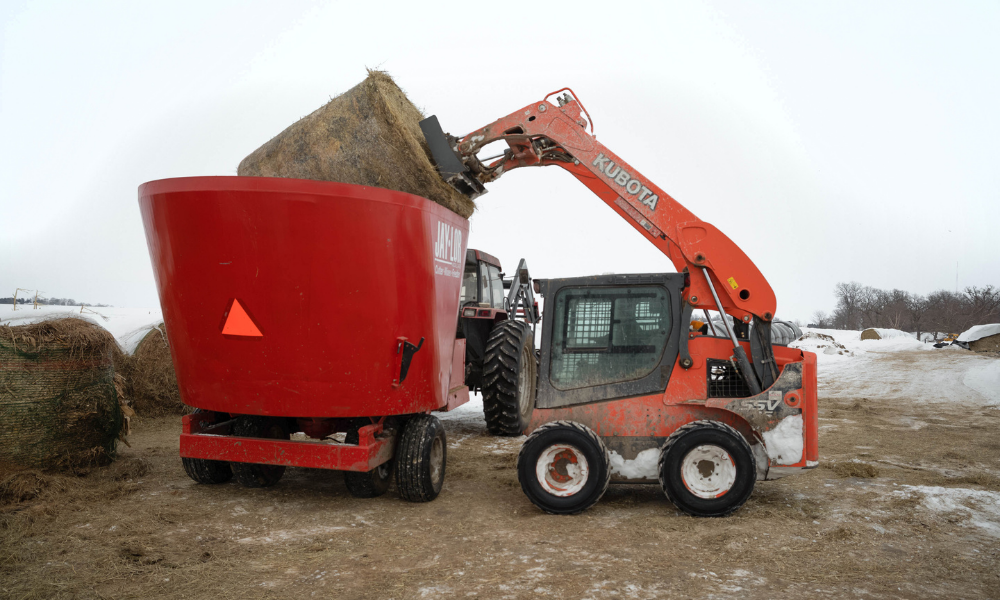
Dave Walton mixes feed for his cattle using biodiesel fuel even during the most extreme weather conditions. (Photo: Joseph L. Murphy/Iowa Soybean Association)
Biodiesel boost in Iowa
March 15, 2021 | Bethany Baratta
Story County farmer Pat Murken believes in streamlining efficiencies, using local products and improving profitability. That’s why he’s drawn to biodiesel which does all three.
“I’m kind of the local cheerleader for biodiesel,” Murken says.
Biodiesel is an efficient fuel, converting homegrown soybean oil to a usable fuel and reducing reliance on petroleum. Murken uses a 20% biodiesel blend (B20) on his own farm from March through November.
The crop farmer said he would use the product all year if he had a need to do so.
Survey says..
Ninety-three percent of farmers responding to an Iowa Soybean Association (ISA) Farmer Member survey conducted by Harvest Research in fall 2020 said they either use biodiesel, have used it in the past or would like to use it in the future.
With regular tank maintenance like changing out his fuel barrel filter each year as the manual suggests, he hasn’t seen any problems using biodiesel.
“Regular maintenance is critical for any form of diesel fuel, including biodiesel,” Murken says.
 Adding value
Adding value
Soybean oil is the primary feedstock for biodiesel produced in the country. About 80% of the biodiesel produced in Iowa contains soybean oil as a main ingredient and it’s a main component of about 50% of the biodiesel produced in the U.S.
Recent studies show that biodiesel production adds about a 13% value to soybeans. With recent soybean prices in the teens, it brings significant value back to the farm, Murken says.
“This business is all about cash flow,” Murken says. “Expanding the use of biodiesel would mean a positive cash flow for a lot of farmers and allow for additional investments and expansion.”
Strengthening demand
In February, Iowa Gov. Reynolds introduced a bill to set a minimum standard of biofuels in the state’s fuel supply. For biodiesel, this would mean most Iowa diesel would contain at least 11% (B11) during warmer months beginning in April 2022, and B20 during warmer months in 2024 and later.
The standard also sets the minimum blend percentage to B5 during the colder six months of the year. The current American Society for Testing Materials fuel standard considers B5 blends the same, no different than diesel fuel.
As of March 9, the biofuel standard bill was under consideration in both the Iowa House and Senate Ways and Means Committees.
Iowa isn’t the only state pushing for higher blends, says Grant Kimberley, director of market development for the Iowa Soybean Association (ISA).
Similar conversations are happening around the Midwest. Bills have been introduced in Colorado, Missouri and Illinois. Minnesota has passed a B20 standard and Nebraska is also discussing biofuel standards.
“It could turn the Midwest into a biofuels corridor,” Kimberley says.
Phasing in the B11 and B20 standards would increase the total demand for soybeans and pure biodiesel. The B11 standard would increase demand for soybean feedstocks by more than 22 million bushels. The B20 standard would demand 31.5 million bushels, Kimberley says.
As companies like Wal-Mart and Amazon and states like California work toward reducing carbon emissions, biodiesel is a part of the solution, says Donnell Rehagen, CEO of the National Biodiesel Board. Modeling suggests that by 2030, the use of biodiesel, renewable diesel and renewable jet fuel will exceed 6 billion gallons in on road, off road, air transportation, electricity generation and home heating applications.
This doubling of the current usage will eliminate more than 35 million metric tons of carbon dioxide-equivalent greenhouse gas emissions annually. It will also boost usage of soybean oil as a feedstock to 18 billion pounds per year which is about two-thirds of the current domestic crush.
“We want to see the growing demand for our fuels be filled by domestic product made from domestic feedstocks. Expansion of soybean oil and crush is going to be a good thing for soybean farmers,” Rehagen says. “So, we ask soybean farmers in the country to keep focused on this and keep producing; we’re going to be able to use all the soybean oil the industry can create.”
Murken says increasing soybean demand through biodiesel production is positive for Iowa farmers.
“I see biodiesel as being a positive addition to my income. And I hope the market triples, because I’m all for it,” he says.
This story was originally published in the March 2021 issue of the Iowa Soybean Review.
Back